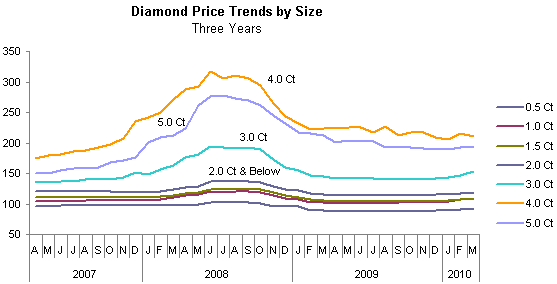IDEX Online Research: Polished Diamond Prices Higher in March (Full Analysis)
April 06, 10
Global polished diamond prices continued to rise in March 2010, according to the IDEX Online Global Polished Diamond Price Index. After languishing for most of 2009, this is the fourth consecutive month that polished diamond prices have risen. It is clear that this is a trend, and it is likely to be sustainable for the remainder of 2010.
Four key factors continue to push polished diamond prices higher:
· Rough diamond prices have risen – Rough diamond prices rose by an estimated 10 percent in 2009, while polished prices remained about flat during the year. After three diamond sales weeks so far in 2010, rough prices are already up by 10 percent so far this year (on an annualized basis, this would equate to a 40 percent rise). Rough diamond pricing pressure is finally having an impact on polished diamond prices.
· Anticipation of re-stocking throughout the diamond pipeline – Inventory levels in the diamond pipeline are very low, especially at the retail store level. Some retailers have begun to re-stock jewelry, after selling down their inventories over the past two years. This increased demand – and the prospects for growing demand, both at the consumer and retail level – have caused polished diamond producers to increase their prices.
· Some retailers have raised prices for diamond jewelry – As diamantaires see that major chain retailers have begun to raise prices at the retail level, they have been emboldened to raise wholesale prices further. Signet Group announced that it raised jewelry prices – including diamond and gold jewelry – between February 15 and March 15.
· Global economy recovering – The global economy is showing solid signs of shaking off the recessionary environment that has existed since late 2007. Further, the U.S. economy has posted solid growth – fourth quarter 2009 GDP rose by a dramatic 5.6 percent (revised) while third quarter 2009 GDP was up a solid 2.2 percent. Two back-to-back quarters of economic growth bode well for diamond demand. Further, the OECD, the international economic think-tank, has released forecasts calling for the global economy to continue to recover this year.
In the past couple of months, most of the strengthening demand has come from smaller weight stones – three carats and less. In February, prices of larger carat stones – four and five-carat items – began to rise on a month-to-month basis, but prices for four-carat stones fell back unexpectedly in March. While prices for smaller gemstones have risen above the level of a year ago, larger gemstone prices still remain below year-ago levels.
Key Statistics – Polished Diamond Prices – March 2010
· The IDEX Online Global Polished Diamond Price Index averaged 113.7 for the month of March, up about 1 percent from February’s average of 112.6.
· The IDEX Online Global Polished Diamond Price Index ended March at 114.6 versus its level at the beginning of the month of 113.2, for a gain of about 1.3 percent.
· The recovery in polished diamond prices began in December 2009. Since the bottom – when the IDEX Online Index bounced along at 108 in the April through November 2009 period – diamond prices have risen by more than 6 percent through the last day of March.
· Polished prices have remained strong in early April.
The graph below summarizes polished diamond price movement based on the IDEX Online Polished Diamond Price Index for the past two years.
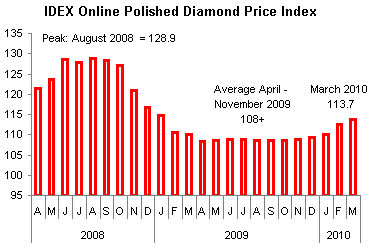
Source: IDEX Online
Outlook: Higher Diamond Prices on the Horizon
Polished diamond prices rose by about 4.8 percent between the beginning of January and the end of March. On an annualized basis, this would be a 19 percent gain. While that dramatic increase is not sustainable for any length of time, it illustrates the momentum that is building to push polished diamond prices higher, both near term and over the longer term. Clearly, polished diamond prices are headed higher.
 |
For the month of March 2010, global polished diamond prices rose 1.0 percent from February, based on average price levels for the month. On an annualized basis, this indicates that global polished diamond prices could rise by as much as 12 percent or so during 2010, if this trend holds. In a recovery period, an annual increase of this magnitude is possible, especially since prices bottomed so low. However, it is not a sustainable growth rate for the long term. Our forecast calls for a modest double-digit gain in polished diamond prices this year. Even if diamond prices rise by 10 percent or so during 2010, they will still end the year below the peak level in mid-2008.
The graph below illustrates month-to-month changes based on the IDEX Online Polished Diamond Price Index.
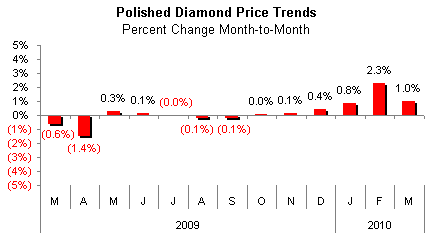
Source: IDEX Online
Year-to-Year Global Polished Diamond Prices Rise 3.4 percent In March 
After declining by mostly double-digit levels for the past year, year-over-year polished diamond prices to show positive comparisons late last year, a trend that continued in March. For the month, the average polished diamond price rose by 3.4 percent compared to March 2009. On an annualized basis, this indicates that polished diamond prices could rise by nearly 41 percent.
Last month, we said that it makes no sense to extrapolate future diamond prices based on the year-to-year price comparison, since we have apparently reached the inflection point in the diamond demand curve. We are still at that inflection point, when the direction of prices is changing from a downdraft mode to an updraft mode. Suffice it to say: diamond prices are headed higher.
The graph below illustrates the year-to-year polished diamond price trends on a monthly basis for the past 13 months.
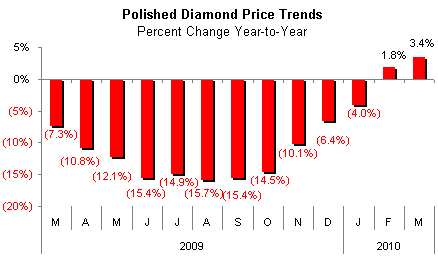
Source: IDEX Online
Polished Price Trends Vary Significantly by Size of Gemstone
When compared to February, diamonds of most sizes showed solid price gains in March, with the exception of four-carat stones. We believe this is an anomaly. However, it is worth noting that prices for larger diamonds – primarily four carats and larger – have been slower to recover than prices for smaller carat diamonds.
We believe that the previous price disparity between smaller stones and larger gems was due to the market during the recession: consumers had been “buying down.” Now that the recession is over, and jewelry demand has perked up, there appears to be demand for all sizes of diamonds.
The graph below illustrates price trends on a month-to-month basis for polished diamonds by key size.
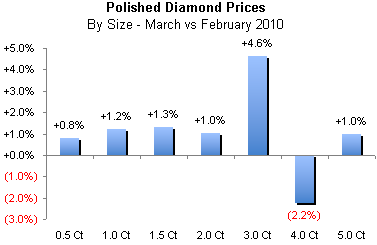
Source: IDEX Online
The good news is that shoppers – and buyers – are back in the malls. The challenge is for jewelers to sell consumers better, larger diamonds.
The table below summarizes month-to-month price movement by key diamond sizes over the past three months.

Source: IDEX Online
Three-Year View Reflects Rising & Falling Diamond Demand
The graph below illustrates polished diamond price trends for the past three years by size, based on the IDEX Online Polished Diamond Price Index. Clearly, a diamond price bubble occurred in mid-2008. The bubble burst late in the third quarter of 2008 as consumer demand waned; diamond prices swooned and financing in the diamond pipeline dried up. After bottoming last year, IDEX Online Research believes the recovery in diamond prices has begun.
|
|
Year-to-Year Diamond Prices Rise for Second Consecutive Month
The table below summarizes the year-to-year price trends for polished diamonds by size over the past three months on a year-to-year basis. The good news is this: the positive numbers from February for smaller diamonds continued into March. However, prices for larger polished diamonds – four carats and larger – continue to lag.
 Source: IDEX Online |
The graph below illustrates price trends in March for key diamond sizes. As it shows, prices for smaller diamonds – three carats and below – show a positive comparison with last year’s prices in March 2009, while larger diamonds lag.
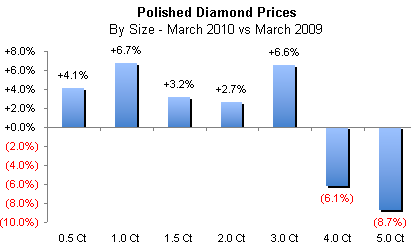
Source: IDEX Online
Strengthening Demand Will Push Diamond Prices Higher
The U.S. is the diamond market to watch. In the third quarter of 2009, its economy grew by a moderate but hopeful 2.2 percent. Further, revised fourth quarter 2009 data showed a dramatic 5.6 percent increase in Gross Domestic Product, the sum of all goods and services produced in the American economy. This sharp growth points to prospects for much stronger economic activity, both near and longer term.
Since American shoppers consume roughly half of the global production of diamonds and diamond jewelry, it is important to focus on this market. For sure, there are other potential growth markets – China and India, for example. But neither of those markets have the significant impact on the diamond industry as the U.S. market. The European market is also important, but it is not a long term growth market, nor is it showing significant signs of a pickup in the various regional economies.
As the U.S. economy recovers, and as laid-off workers return to their jobs, Americans will loosen their purse strings even more. As we have said on numerous occasions, the so-called Great Recession of 2007-2009 will not de-rail 50,000 years of humans’ cultural affinity for gemstones, precious metals and jewelry.
